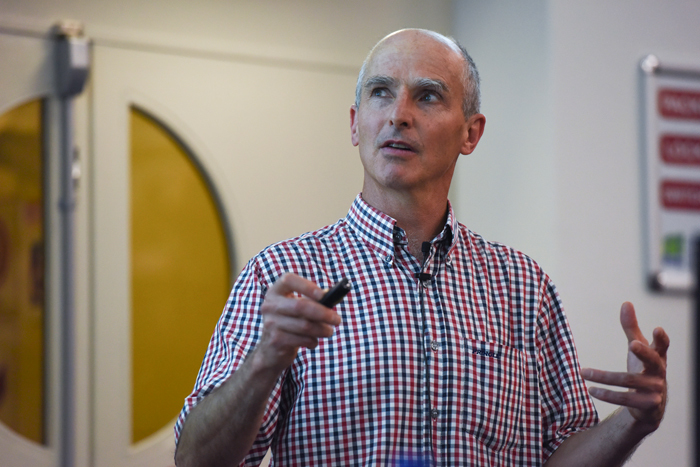Was 'forward panic' to blame for what unfolded at Marikana's Scene 2?
11 February 2016 | Story by Newsroom
Researcher and writer David Bruce proposed a new theory of what went through the police's minds as he walked a Summer School audience through what has become known an Marikana's 'Scene 2', where 17 miners were shot dead.
Were the police officers who killed 17 miners in the second round of shooting at Marikana on 16 August, 2012, consumed by what sociologists call a 'forward panic'? David Bruce, an independent researcher and writer, offered this theory at a recent UCT Summer School lecture.
In his lecture, he argued that the police action at what has become known as 'Scene 2' at Marikana betrayed some tell-tale signs of 'forward panic', a term coined by US sociologist Randall Collins to describe how confrontational tension can erupt into violence.
Police showed 'a kind of elation'
The story of what happened at Marikana's Scene 2, the bushes and koppies where some miners ran to after the initial shooting, was not reflected in Judge Ian Farlam's Marikana Report, beyond saying that the police's account did not match up with the evidence.
Bruce stitched together his own narrative, using photographic and other evidence, and shared it with a UCT Summer School audience in a lecture titled The Sound of Gunfire: Marikana Scene 2.
Bruce suggested 'forward panic' as a possible explanation for the police's actions at Scene 2.
“A forward panic is not a panic, but has certain features that resemble a panic,” said Bruce, pointing to increased heart rate and so on. But a forward panic lacks the fear embedded in a typical panic.
“In the penultimate moment, the opponent, [and] the threat that's posed by the opponent falls away. What Collins says is that what comes into play is a range of different emotions, which might include anger, fury, and might also include a type of exuberance,” said Bruce.
“In some ways, what happened at Scene 2 would have followed the classic pattern that Collins describes.”
He illustrated this theory with an example. “Immediately after the shooting, there is this type of bragging, kind of elated mood that is apparent from some of the police involved,” said Bruce, referencing video and audio recordings. “So forward panic might have been an element of what happened at Scene 2.”
Bruce had weighed up three other theories about how and why the striking miners were shot and killed at Scene 2: that the 17 striking miners were killed by police acting in self-defence, that the deaths were deaths in crossfire, and that the deaths were executions.
Miners kraaled in
To illustrate his take on those theories, Bruce showed the Summer School audience photos of the unfolding carnage. The audience had a bird's eye view of miners huddled in small groups around the koppie and in the bushes, ostensibly hiding from police, while uniformed gunmen trained weapons in their direction and water cannons were fired around them.
There was evidence of dishonesty by police at Scene 2, said Bruce. Not only was their version of events not accepted by the commission of inquiry, but the police's testimony in fact changed during proceedings. Photographic evidence also proved that police had planted weapons on some of the dead miners' bodies at Scene 2, he asserted.
On the self-defence theory, Bruce said there was little if any evidence suggesting that police were under attack from miners at Scene 2, which is where miners had run after the initial volley. As for crossfire, Bruce confirmed that some miners had indeed been caught in crossfire, but this was because they were being shot at by police from all sides – not your usual “cops and robbers” situation, said Bruce.
As for execution, Bruce noted a miner's testimony that the police shot surrendering miners. However, he explained that ballistics analysis suggested that miners weren't shot in a 'traditional' close-up, kneeling execution style.
One of the dead was not a miner
Before commencing his main arguments, Bruce cleared up some facts that are not often mentioned in popular conversations about the massacre. Of the 34 people shot dead by police that day, 33 were miners, and one was a man who happened to be with the group of miners at the time.
Then there was a discrepancy in the duration of the Scene 1 shooting (some of these visuals were broadcast on the night of the massacre) and Scene 2 where the first volley, which occurred near a small kraal in front of the koppie on which some miners were gathered, lasted roughly 10 seconds. Here, 17 people were killed. According to Bruce, one man was 250 metres away when a bullet from an R5 rifle hit him.
Minutes later, and about 500 metres or less away, 17 more miners were killed by police at Scene 2, in a series of shots that lasted some 11 minutes. That it took so much longer than the first burst of gunfire, despite a similar number of cartridges being fired at both scenes, was something Bruce noted with interest.
If one could indeed differentiate the Marikana massacre into a Scene 1 and Scene 2, as the Farlam Commission did, Bruce held the events of Scene 2 as “greater atrocity”, if it was possible to distinguish between them.
“There's no accountability as yet from any police shooter,” Bruce concluded. “No police shooter has been charged or prosecuted. No police shooter has, as yet, even been suspended for any of these shootings.”
Story by Yusuf Omar. Photo by Michael Hammond.
 This work is licensed under a Creative Commons Attribution-NoDerivatives 4.0 International License.
This work is licensed under a Creative Commons Attribution-NoDerivatives 4.0 International License.
Please view the republishing articles page for more information.










